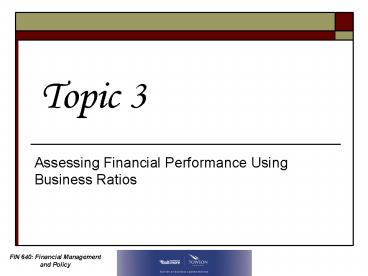Assessing Financial Performance Using Business Ratios PowerPoint PPT Presentation
1 / 29
Title: Assessing Financial Performance Using Business Ratios
1
Topic 3
- Assessing Financial Performance Using Business
Ratios
2
Learning Objectives
- LO 3.1 Calculate the various business ratios
using real world financial statements using
Excel. - LO 3.2 Calculate the DuPont identity using
Excel. - LO 3.3 Use business ratios and the DuPont
identity to analyze the financial standing of the
firm in comparison to both the history of the
firm and external benchmarks. - LO 3.4 Use the Key Business Ratios database to
investigate firm and industry ratio benchmarks.
3
Excel Features Annuity Functions
- NPER(rate, pmt, pv, fv, type)
- Total number of periods
- RATE(nper,pmt,pv,fv,type,guess)
- Interest rate per period
- guess may be necessary if program gets stuck
- PMT(rate,nper,pv,fv,type)
- Constant payment amount
- PPMT(rate,per,nper,pv,fv,type)
- Principal component of PMT
- IPMT(rate,per,nper,pv,fv,type)
- Interest component of PMT
4
Key Concepts and Skills
- Know how to standardize financial statements for
comparison purposes - Know how to compute and interpret important
financial ratios
5
Chapter Outline
- 3.1 Financial Statements Analysis
- 3.2 Ratio Analysis
- 3.3 The Du Pont Identity
- 3.4 Using Financial Statement Information
6
3.1 Standardizing Financial Statements
- Common-Size Balance Sheets
- Compute all accounts as a percent of total assets
- Common-Size Income Statements
- Compute all line items as a percent of sales
- Standardized statements make it easier to compare
financial information, particularly as the
company grows. - They are also useful for comparing companies of
different sizes, particularly within the same
industry.
7
3.2 Ratio Analysis
- Ratios also allow for better comparison through
time or between companies - As we look at each ratio, ask yourself
- How is the ratio computed?
- What is the ratio trying to measure and why?
- What is the unit of measurement?
- What does the value indicate?
- How can we improve the companys ratio?
8
Categories of Financial Ratios
- Short-term solvency or liquidity ratios
- Long-term solvency, or financial leverage, ratios
- Asset management or turnover ratios
- Profitability ratios
- Market value ratios
9
Custom Ratios
- Traditional ratios are the most useful for
general applications. - To meet specific needs, you can construct your
own ratios.
10
Liquidity Ratios
- Current Ratio
- Quick Ratio
- Cash Ratio
11
Liquidity Ratios
- Liquidity is the ability to convert assets to
cash with significant loss of value - Differing time horizons for liquidity
- Cash Ratio ______________
- Quick Ratio ______________
- Current Ratio _____________
12
Leverage Ratios
- Total Debt Ratio
- Debt/Equity Ratio
- Equity Multiplier
13
Coverage Ratios
- Times Interest Earned
- Cash Coverage
14
Coverage Ratios Custom
- Son of Cash Coverage
- What might be an application?
15
Leverage and Coverage Ratios
- These are measures of the long-term
sustainability of the firm. - Bankruptcy is a function of debt.
- Leverage ratios measure how much debt.
- Coverage ratios measure how well the firm can
support its debt.
16
Inventory Ratios
- Inventory Turnover
- Days Sales in Inventory
17
Receivables Ratios
- Receivables Turnover
- Days Sales in Receivables
18
Turnover Ratios
- Total Asset Turnover
- It is not unusual for TAT lt 1, especially if a
firm has a large amount of fixed assets.
19
Turnover Ratios Custom
- Fixed Asset Turnover
- What might be an application?
20
Turnover Ratios
- Inventory, receivables and turnover ratios
measure how efficiently we different asset
classes with reference to some standard, e.g.,
sales. - One goal is to produce sales. The Total Asset
Turnover Ratio measures the relationship between
sales and a dollar spend on total assets. - For example if the ratio were 5 times, that
would mean that, on average, 1.00 in assets were
needed to generate 5.00 in sales.
21
Profitability Measures
- Profit Margin
- Return on Assets (ROA)
- Return on Equity (ROE)
22
Market Value Measures
- Market Price 88 per share
- Shares outstanding 33 million
- PE Ratio
- Market-to-Book Ratio
23
Market Value Measures Custom
- Instead of using book value, we could use Tobins
Q - Why Tobins Q rather than Book Value?
24
3.3 The Du Pont Identity
25
Extending the Du Pont Identity
x
x
-
26
Using the Du Pont Identity
- Profit margin is a measure of the firms
operating efficiencyhow well it controls costs. - Total asset turnover is a measure of the firms
asset use efficiencyhow well it manages its
assets. - Equity multiplier is a measure of the firms
financial leverage.
27
3.4 Using Ratios
- Ratios are not very helpful by themselves they
need to be compared to something - Time-Trend Analysis
- Used to see how the firms performance is
changing through time - Peer Group Analysis
- Compare to similar companies or within industries
- ______ codes
28
Web Resources
- Research Port (UMD Libraries)
- Key Business Ratios
- Ratios and ranges for SIC industries
- Mergent Online
- Ratios for particular firms
29
Potential Problems
- There is no underlying theory, so there is no way
to know which ratios are most relevant. - Benchmarking is difficult for diversified firms.
- Globalization and international competition makes
comparison more difficult because of differences
in accounting regulations. - Firms use varying accounting procedures.
- Firms have different fiscal years.
- Extraordinary, or one-time, events

